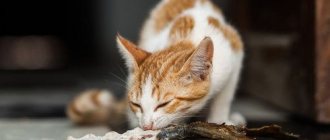Most people, without thinking, will answer the question: “What are cats most afraid of?” Of course, water! Can they answer why cats are afraid of water? Genetics, evolution, personal dislike, phobia? What is the reason for the seemingly irrational fear inherent in these brave creatures?
Zoologists at one time paid close attention to this issue. Probably just out of curiosity, but it was worth it: it turned out that the mustachioed hunters are not afraid of water at all, and do not want to get wet for completely rational reasons.
Risk of hypothermia
Between the top layer of fur and the cat’s skin there is a “layer” of air - the so-called air cushion. This is a protective layer that is heated by the warmth of the cat's body and prevents the pet from freezing. When wet, wool loses its insulating properties. But why are cats afraid of water and dogs are not? To understand, you need to remember the lifestyle of these two animals.
A dog is a pack animal; if it gets cold, it will cuddle up to its fellow tribesman and warm up. The dog hunts, chasing prey - it ran and dried up. The dog tracks game, covering long distances - it has walked and dried off. In addition, they also know how to shake themselves off - droplets of water literally slide off the fur covered with sebum. Now it’s obvious why cats don’t like to swim: there’s no one to snuggle up to, they wait for prey almost without moving, they rarely leave the territory (almost never, to be precise), and they don’t know how to shake themselves off. She lay there and froze while the dog frolicked and dried out. Of course, a pet is unlikely to become hypothermic if it dries out in an apartment, but at the genetic level it “remembers” that wet fur will not protect against the cold.
Reasons for hostility
To understand the reasons for this behavior, you need to know some features of the physiology, as well as the character traits of felines. As it turned out, cats are afraid not so much of water or its murmur as of the consequences associated with water procedures.
Violation of thermoregulation
A cat's coat provides good thermoregulation due to the air gap between the individual hairs, which protects the animal from hypothermia or overheating and maintains optimal body temperature.
Wet and matted fur is not able to reduce heat loss or protect the body from the cold, so the pet begins to freeze, regardless of the temperature in the room. In addition, when wet, the temperature of the skin drops by 5-7°C. If a dog immediately shakes himself off after water treatments to get rid of excess moisture, cats don’t know how to do this, so they dry out much longer. Only a warm and dry towel will help in such a situation, because the faster the cat dries, the faster it will calm down.
Increased body odor after getting wet
Despite the fact that these animals have been domesticated for a long time, ancient hunting instincts make themselves felt. Cats are predators by nature, but unlike dogs, they do not chase prey, but patiently wait for it in ambush, trying not to attract attention to themselves in order to attack at the most opportune moment. After the wet fur gradually dries, the body temperature increases and the natural odor of the skin intensifies, which can scare away prey, so the animal instinctively feels unprotected and remains irritable for some time after contact with water.
Using detergents
If detergents are used during bathing, they wash away the natural lubricant that protects the hair from brittleness, and the animal’s natural instinct tells the animal that degreased wool does not bring anything good. In addition, detergents contain aromatic additives, and the perception of odors by cats and humans is significantly different due to the more developed cat's sense of smell. What seems like a pleasant aroma to us causes negativity and irritation in a pet. Even special shampoos purchased at a pet store may not be to his liking, as they will leave an unpleasant aroma on the skin. For this reason, cats begin to lick themselves immediately after bathing in order to get rid of an unnatural and unpleasant odor.
Stressful situation
Washing is perceived as a procedure imposed by a person, performed against the will of the pet, and therefore is a source of stress for him. In addition, they are accustomed to independently grooming their fur and cleaning it using their tongue. Bathing seems simply pointless to them and causes a lot of unpleasant sensations, which is why such an aggressive reaction appears with the release of claws, heart-rending meows and attempts to quickly escape from the owner’s hands.
Note: Cats have a negative attitude towards any sources of water, for example, rain, because in addition to adding a “wet” sensation, its noise disorients the animal. They are also wary of dew and, if they have to move through it, they do so with quick but careful steps. According to some studies, this is due to the fact that dew on the sensitive whiskers causes discomfort.
Exceptions to the rules
But you can find representatives of cat breeds that get along very well with water, for example, jungle cats are able to fish very well. Owners of Maine Coons, Bengal cats and Kurilian Bobtails in most cases do not have difficulties with washing their pets; some of them prefer to climb into the bathroom themselves and wait for a bath. And representatives of the Siamese breed are generally characterized by an increased love for water procedures, because, according to legends, they were present when bathing princesses, allowing them to put precious rings on their tails.
Can cats swim?
Of course yes. Moreover, felines are excellent swimmers by nature, capable of covering considerable distances, disdainfully stretching out their faces above the water and opening their sparkling eyes in horror (apparently, they are going through the consequences of getting wet in their minds). It is interesting that cats can swim almost from birth - even one-month-old kittens actively work with their paws, scooping up water like a dog.
But why would cats, who hate water, need this skill? It's not hard to guess: cats can swim, like most warm-blooded animals, literally just in case. What if there is a flood? Or will the pursuing enemy drive you straight to the river?
Fear of changing familiar surroundings
When picking up an animal from the street, trying to give it a bath without hysterics is impossible. The fact is that wild cats have already developed a dislike for water and therefore they will not surrender into the hands of an owner who wants to wash the pet without a fight.
The same applies to pets who have never been bathed, but then they suddenly start throwing water on them. This feeling is unfamiliar to them, which is why they panic and begin to break free. Of course, you need to pay attention to the hygiene of cats, but if they show strong aggression when trying to bathe them, then it is better to abandon this idea. You can clean their fur without dipping it in water. All you need to do is wet a washcloth and wipe your cat’s coat with it.
Waterfowl
Strange but true: many wild cats have no fear of hypothermia, overheating or germs. They are not even afraid of the smell, which makes the cat more noticeable to prey and potential enemies. Wild cats that love to swim happily frolic in the water, dive and catch splashes, absolutely not thinking about the consequences of getting their fur wet: tigers, servals, jaguarundi, Sumatran cats.
The lifestyle of the speckled cat is remarkable. Viverrina would probably be very surprised to learn that some people doubt whether cats can swim. This savage does not miss a single chance to splash around, diving deeply and swimming several meters underwater. In addition, she hunts fish, preferring river inhabitants to land-based prey.
Physiological features
A detailed examination of a cat's paws shows that they consist of tiny toes, with no membranes between them. Because of this, it is difficult for animals to row, stay afloat and move quickly in the water.
In addition, cat hair gets wet easily because it is not covered with a natural water-repellent film. Water makes the body heavy, depriving animals of their innate speed, agility and chances of salvation. Cats know that they are bad swimmers. Therefore, they avoid water and everything connected with it in every possible way, even if their beloved owner is nearby.
Another reason why cats do not like to swim is the temperature characteristics of their body. To maintain the normal functioning of internal organs, the animal needs a body temperature of 37.5 to 39 degrees Celsius. When wet, its fur loses its thermal insulation properties and the cat begins to freeze. Hypothermia leads to inflammation, colds and a number of disorders in the body.
Bathing with detergents intended for humans is dangerous for cats. Some of the shampoo will remain on the fur, the animal will lick it off and may become poisoned.
Domestic swimmers
Domestic cats that are not afraid of water are not that uncommon. Many pets enthusiastically play with the stream running from the tap, catch droplets of rain, and stir up the water poured into the pan with their paws. Some even cool down on hot days by putting their heads under the stream flowing from the tap. Special unique ones jump into the bathtub when the owner is taking a shower: either for company, or out of curiosity, but on their own, voluntarily!
Very roughly, we can name the breeds of smart cats that love water: Bengal, Turkish Van, Sphynx, Rex, Kuril Bobtail, Savannah. However, these are only general trends, since all cats have an individual character.
The attitude towards water is often formed during the first “meeting” with the mysterious element
And here lies another reason why cats don’t like water. A freedom-loving, proud, independent and even sometimes arrogant pet, she does not tolerate violence, rough treatment and coercion. And owners often make a difficult mistake to correct already during the first bath, by forcefully holding the cat in the bath, scolding it for bad behavior and not giving it the opportunity to “get acquainted” with the water in a calm environment. Fear-stress-fear for life.
How to train your pet not to be afraid of bathing
You need to get used to the process of bathing gradually. You should not bathe a kitten until 4 months of age - this can lead to severe hypothermia and a decrease in immunity.
Do cats need to be washed at all?
We must remember that the wild brothers and ancestors of modern domestic purrs were inhabitants of dry steppes who ate fresh prey and did not need additional drink. In addition, whiskers are very clean creatures that do an excellent job of tidying themselves up with the help of their tongue. By licking themselves, they break down contaminants with their bactericidal saliva and easily get rid of them.
A pet rarely needs to be washed by a person. Moreover, some veterinarians are against this procedure, because it is fraught with complications and is almost always accompanied by negative emotions.
You should not bathe your pet more than once a quarter, but it is better to carry out the procedure 2-3 times a year. The only exception may be an allergic reaction to the fur of a furry friend on the part of the owner and family members. Other reasons to wash your pet:
- the cat is not very clean;
- Dirt cannot be removed by regular licking;
- the wool gives off an unpleasant odor;
- ectoparasites (fleas, lice eaters, etc.) appeared on the body.
The need to use detergents is also associated with the prevention of skin diseases. In addition, if a handsome man with a mustache participates in exhibitions or championships, then he will have to be tidied up before each public appearance.
6 stages of training
A furry dog of any age will react negatively to the owner’s attempts to put him in the bath. Therefore, so that the cat is not afraid of water, it must be gradually accustomed to washing.
It’s good to start by introducing the mustache to the environment in the room. The animal must sniff everything, get used to unknown sounds and smells.
Experienced owners advise putting the animal in a dry bath and putting his favorite toys in there. Over time, the animal will stop panicking and running away. Then you can begin the first bath procedure. It occurs in several stages:
- Pour a few centimeters of water into a bathtub or basin and place a towel or mat there to prevent the mustache from slipping.
- Slowly lower the animal into the container.
- Wet your pet's fur. If he is calm, then you can turn on the shower.
- Lather your body with shampoo and massage thoroughly. Do not allow foam to get into your pet's ears, nose or mouth.
- Rinse off the shampoo and remove the cat from the container.
- Dry the wool with a towel and then wrap it in a dry sheet or other towel.
After bathing, it is not recommended to dry the animal's fur with a hairdryer. This can be scary and uncomfortable. The first wash should not last long. In the future, the duration of the procedure is determined individually.
How to teach a cat to love water?
Since Nature herself took it upon herself to teach a cat to swim, the owner only needs to show the pet that water procedures are not only not dangerous, but also fun.
First “meeting”: a shallow bowl, five centimeters of water and floating objects (pieces of polystyrene foam, chocolate egg containers, etc.). We place the bowl on the floor and attract the pet’s attention by throwing toys into the water. The main thing is to do it carefully, without splashing. Sooner or later, a curious cat will not be able to resist and will try to catch the “prey”.
A representative of a breed of smart cats who love water can immediately be subjected to a more difficult test: a shallow wide basin, ten centimeters of water and mechanical floating toys. We proceed as described above.
When the cat gets bored of playing with splashes in the basin, it’s time to go to the bathroom: pour some warm water and throw mechanical toys in there
We place a wide, heavy board across the bathtub (so that it doesn’t rattle and “drive away” when the pet jumps). Some breeders put live fish in the bath, which is even more attractive. We show the cat the “battlefield” and enjoy the spectacle. Having jumped from the board into the bath for the first time, your pet will probably jump out of there with lightning speed. But since no one and nothing is holding her back or forcing her, she will return to the game, because she can always leave.
Gurgle-gurgle: cat takes a bath
Why doesn't your cat like water? Petful offers a different answer: "Cats are also very sensitive to odors, so it is assumed that your cat may not like the smell of chemicals present in tap water." The situation gets even more complicated when you consider shampoos that are full of unfamiliar scents.
However, this should not stop you from bathing your cat if she needs it. You can do this if you have the right tools and techniques at hand. The essentials in this case are towels, rubber gloves, mild detergent and post-bath treats. However, the biggest help in bathing your pet will come from a trusted friend or family member who will be patient with your naughty pet. How often should it be washed? Your cat's desire for constant bathing will ensure that she doesn't need to bathe as often, but if she gets really dirty, you may want to know some tips and tricks to help with this task.
Bacteria and dirt on wool
If an animal's fur is wet, it instantly becomes covered with dirt and dust. A cat, trying to lick its fur, does so along with dirt and bacteria, which, after entering the animal’s body, cause various diseases. Harmful microorganisms generally like to settle in damp areas, and such animal fur is an ideal place for reproduction. This is why zoologists say that a cat is naturally designed to “intuitively” recognize what is bad for it and what is good. She herself understands that she can introduce infections into her body, and therefore consciously tries to stay away from water and bodies of water.
Chasing waterfalls
As a cat owner, you may notice that although she doesn't like being wet, she loves to play with water. Whether she's catching drips of water from the bathroom faucet, drinking from the indoor fountain (great if your cat needs more water), or trying to get her paw under the shower, she's all about fun and games (as long as she doesn't gets very wet).
Experts theorize that a cat prefers running water (such as a kitchen sink) over standing water (such as a bathtub) due to its sparkling allure. Dripping water "is a cat magnet," Animal Planet reports in a study on cats' senses. It is also possible that her instincts associate running water with fresh streams, which in the wild are safer to drink from than a puddle of standing water.











